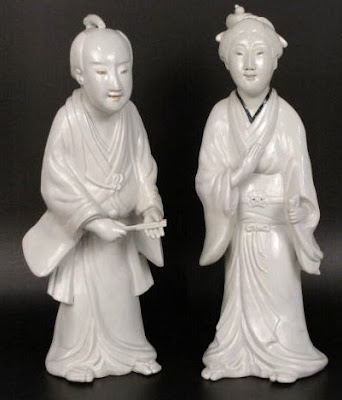 |
| photo: Melanie Acevedo Part of Mary McDonald's collection of blanc de Chine, as seen in Mary McDonald: Interiors: The Allure of Style |
A (I promise you) Brief History
Porcelain is a mixture of clay, feldspar and flint that can be fired at high temperatures, rendering it somewhat translucent, in addition to being smoother and more durable than many other ceramics. The Chinese invented it (which is why we refer to those plates in our cupboards the way that we do), precisely when is a matter of debate, but the country was definitely exporting porcelain to the Middle East by the Tang Dynasty (618-906). In the 16th century, when trade finally opened up in other parts of the globe, the European upper classes got a glimpse of porcelain for the first time and "Chinamania" ensued. (It took them several decades to successfully produce their own, which finally happened in 1707 in Meissen, Germany, but Meissen, my dearlings, is a topic for a different time)
 |
| photo: Melanie Acevedo A guanyin from Mary McDonald: Interiors: The Allure of Style |
 |
| 17.5" Chinese Quan Yin, at auction June 12th. |
Today, the most common blanc de Chine items at auction are guanyin, or Quan Yin, the bodhisattva associated with compassion in South Eastern Buddhism, such as the one, left, at auction at DuMouchelles in Detroit on June 12th, with a starting bid of $90, or the seated guanyin, below, at auction on June 9th, through Leslie Hindman in Chicago, with a starting bid of $250.
 |
| Guanyin on a kylin, at auction June 9th. |
 |
| Buddha available at auction on May 30th. |
 |
| Set of porcelain available for bid on June 5th. |
 |
| Hirado figures, sold at auction for $825 at S&S Auctions in New Jersey on May 16th. |
Japanese blanc de Chine, often from Hirado, can be distinguished from its Chinese counterpart by its mostly closed base, below.
European blanc de Chine goes farther afield, literally: birds, flowers and animals are common subjects.



No comments:
Post a Comment